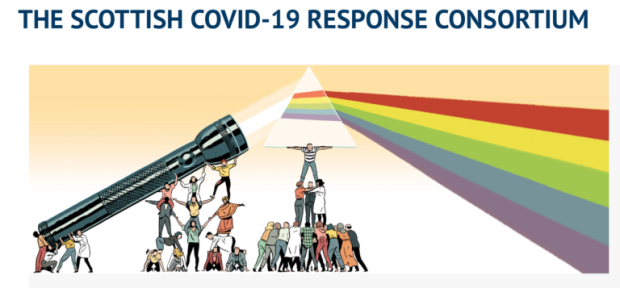We were songbirds, we were Greek Gods
We were singled out by fate
We were quoted out of context – it was great.
Prefab Sprout, “Electric guitars”
Those who know me well, will know that I am a bit of a linguistics and language nerd. PhD students of mine have even claimed that I can turn every conversation into a conversation on language and linguistics. Well, here we go! One of the excitements of linguistics to me is finding out and speculating about the origins of words, spotting similar words in different languages and figuring out what proper linguists have to say about my musings. I get particularly excited when the modern usage of a word varies from the original meaning or has become narrower in its meaning. The English language with its many sources and influences is particularly exciting here.

You will not be surprised that I chanced upon a word and its Latin origin when I was trying to summarise for this blog how statisticians have reacted to the pandemic that has made top news every single day since early 2020. What has our role as statisticians been in this crisis and has this been a new or different role from before?
Judging by my own experience I am reaching for a single word here, that of translators. You have probably guessed what is coming next… The linguist in me knows that the word “translation” derives from the Latin word translatus, -a, -um the past participle of the verb transferre. The verb transferre itself originally means “to bring, move or carry across.” And this is really what I feel many of us have been doing this past year – we have translated, we have carried across. We have translated not only in the narrow sense of the word in terms of facilitating and supporting communication between people with different (scientific) languages, say. That would not be all that new and hence not worth dedicating a blog post to. Many applied statisticians have done this in the past. However, since the start of the pandemic, statisticians have also been translators in a more general sense of the word, let me explain…
When the pandemic was declared in March 2020, everyone, not just statisticians, started staring at numbers and trying to make sense of statistics to understand the world around them. I guess many of us sensed that this might be a rare moment in history with the world having their eyes on statistics. With statistics in the lime-light, some of us statisticians might have thought that this was finally our opportunity to become famous. Finally, we could have said, fate led us to the point where the world needed us- and was listening to us.
At that point everyone could have turned to their favourite methodology and started selling it to the world as the very best method to predict what was going to happen in the pandemic and eventually become famous. But wait- this was not the world as we knew it! This was a different world, a scary new world with new rules. The usual processes of scientific development that we are used to do not apply in pandemics. It has been important to react differently, and it has to be fast!
Right, so this was not about individuals becoming famous by selling their own favourite method. This was about adapting to the new challenges as a team – i.e. the first translation we undertook was stepping into this new fast moving world and redefining our role. And – to be honest- we don’t exactly have a track record of selling most of our work to the world, do we?

Reacting to the crisis meant that we had no time to compete for grants that would allow us to develop new methods that would eventually be published and perhaps used in practice years down the line. We had to take what we had and run with it – a rather speedy translation! This meant we had use existing skills, experiences, and networks; and use them where they are most needed, playing to our strengths and supporting the needs of others, rather than competing with them. Let me illustrate this with some examples.
In Glasgow, the Scottish Covid-19 Consortium (SCRC) formed within days of the first lockdown, consisting of large numbers of volunteers at all career stages and with a variety of backgrounds. SCRC has been aiming to provide transparent and well tested data and modelling pipelines combining several epidemiological models. These were based on existing models for animal diseases, some of them originating from the aftermaths of the foot-and-mouth crisis in the UK in 2001. Statisticians have had a number of roles in this development – ranging from students getting involved in literature reviews used to parameterise the models to using state-of-the art methods for uncertainty quantification in the context of the epidemiological models. For many of us this involved stepping out of our comfort zone into epidemiology – another translation – and supporting the modellers.

Another Glasgow example is ongoing work that uses our statistical expertise combined with existing links to charities and government organisations to support the reaction to the pandemic in low and medium income countries, currently in particular in Bangladesh. Researchers in Glasgow already had strong links to organisations through previous work on infectious diseases, such as rabies. Here, the “take what we have and run with it” approach has enabled us, for example, to the provide recommendations to the Foreign, Commonwealth & Development Office (UK) on the modelling and data situation in Bangladesh. Similarly, we have been assessing the effectiveness of rapid antigen tests when combined with data available through existing local community support teams in Bangladesh, where PCR testing capacities are limited.
Of course, I could list large numbers of examples of other statisticians beyond the groups I have been involved in, who have supported the fight against the crisis through translation both in Glasgow and elsewhere. In Scotland, a comprehensive dashboard summarising data coming from a number of official sources was created and is maintained by John Frace, better known as the Travelling Tabby. He even became a statistician in the process!
Further afield others have used their statistical expertise and explained statistics to the general public by publishing newspaper articles and commenting on statistical issues to reach the general public. For instance, Marta Blangiardo and Gianluca Baio explained the difficulty of counting deaths from the virus in this article in the Guardian early on in the pandemic. Similarly, Anthony Masters and David Spiegelhalter, who has a strong track record in explaining (translating!) statistical risks to the public, described in this article how the risks of vaccinations were outweighed by the benefits.
So in the end most of us have not become famous, and we are not in the lime-light, which might be a good thing. However, politicians base important decisions on our work, which is open to misinterpretation and can be quoted out of context. In other words, statistics is still in the lime-light and unlikely to be a one-hit wonder. Large amounts of data will continue to be widely available, and there is likely to be another crisis where people are looking for answers. Let’s hope we have learned enough translation skills in this crisis to be prepared for that next one and that we will be able react quickly and responsibly.





